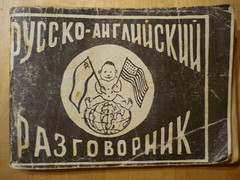“They inquired about the development of production in the light metal industry, like children asking the exact size of the grapes of Canaan.” – Arthur Koestler’s Darkness at Noon
I now have a Russian aunt. Together with her son, from a previous marriage, she has added a wonderful new multi-cultural dimension to my trips back to my hometown in Stavanger, Norway, where I stay in my mother’s apartment just under my uncle’s house. I have enjoyed my many chances to talk to them both and learn more about Russia and Russian. This was made simple given the fact my aunt speaks fluent English and her son increasingly fluent Norwegian, even though the two of them have lived in Norway less than a year.
This summer, my aunt Lena’s parents, both doctors, visited from Russia. I met them first in my uncle’s garden, which they immediately – and spontaneously – assumed supervision of, and I took a liking to both of them immediately. They were both incredibly active, healthy, full of childish vigor, and curious about the country they were visiting.

Granpa Alex on the ropes, with my aunt Lena and cousin Max outside my uncle’s house in Stavanger, Norway.
Communication was always difficult, however, since I don’t speak Russian yet and neither of them speak any English. When my uncle and my aunt left for a week of vacation, my daily interaction with them mostly consisted of some dozen greeting related phrases of Russian I had learned, quick single word lookups in a Russian-English dictionary I had on my iPod Touch, and a few random German words we hoped the other would be able to understand.
We started with greater ambitions. I spent my first evening with the couple mostly with Alex, the father, and we tried to teach eachother some English and Russian, respectively, with the use of a well-worn phrase book he had brought with him from Russia:
Русско-английский разговорник
(Russian-English phrasebook)
Guessing from the first pages, it looks like it was published originally in 1957 and reprinted as late as 1991.
Most of the phrases were very basic and still good choices for a phrase book of this kind. “How are you,” and “I have a cold,” for example. However, in this small pocket booklet of perhaps 150 pages things quickly got more technical, with some fascinating entries which really have a classic Soviet appeal.
You can view a collection of my favorite pages from the book here, but here are a just few phrases that were included in this beginner’s phrase book:
-We want to see the new types of reinforced concrete (metal) structures)
-Show us the agricultural machinery.
-What is the capacity of the lathe?
-We should like to see designs of apartment houses (industrial buildings).
-What special combine harvesters have you?
-Are you a member of the National Farmer’s Union?
-We should like to meet some members of Parliament.
-What is the membership of the National Union of Railwaymen (the Amalgamated Union of Foundry Workers, the Amalgamated Engineering Union)?




